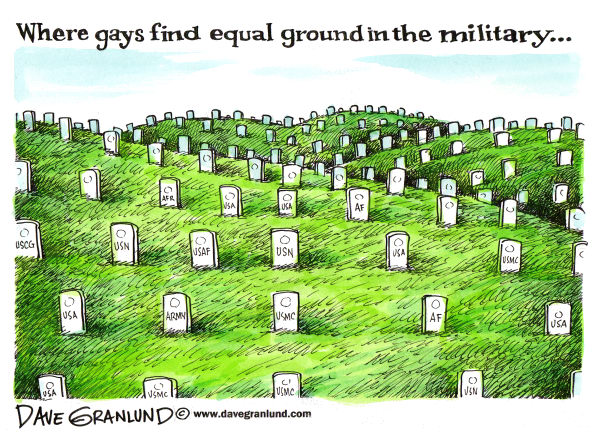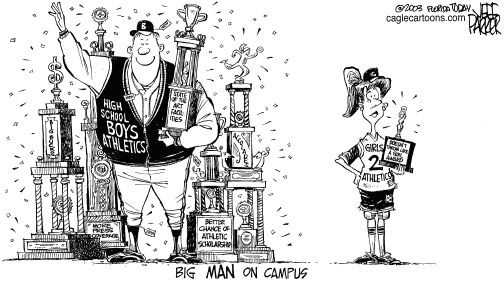
Please check parent connect....have I missed something you sent along? Did you not send along an assignment?
Learning Targets:
I can cite strong and thorough textual evidence to support analysis of what the text says explicitly as well as inferences drawn from the text, including determining where the text leaves matters uncertain.
I can determine an author's point of view or purpose in a text in which the rhetoric is particularly effective, analyzing how style and content contribute to the power, persuasiveness or beauty of the text.
I can integrate and evaluate multiple sources of information presented in different media or formats
Essential question: How effective are satirical cartoons in conveying a social justice issues?
Below you will find 4 cartoons that focus on social justice issues: racial profiling, poverty and environmental justice, gay rights and gender discrimination.
Assignment: I have used different formatting to approach each of the 4 cartoons: 2 graphic organizers and 2 with a series of questions. All require that you look carefully at the cartoon and read the supporting material. I suggest that you copy the material onto a word document and work for there. This is due at the end of class tomorrow, Tuesday. March 15
Editorial Cartoons to Teach Social Justice
Essential Questions
- How are editorial cartoons different from other kinds of art and media?
- Why do artists create editorial cartoons?
- How can images and text work together to deliver a message?
- How do I interpret an editorial cartoon?
- What are the important elements that many artists use in editorial cartoons?

Visuals
|
Words (not all cartoons contain words)
|
1.1. List the people or objects you see in the cartoon.
|
1.2. Identify the cartoon caption or title.
1.3. Locate three words or phrases used by the cartoonist to identify objects or people within the cartoon.
1.4. Record any important dates or numbers that appear in the cartoon.
|
1.5. Describe the action taking place in the cartoon.
| |
1.6. Explain how the words in the cartoon clarify the symbols.
| |
1.7. Explain the message of the cartoon.
| |
1.8. What special interest groups would agree/disagree with the cartoon's message? Why?
| |
1. 9. How is the cartoonist employing the strategy of irony?
| |
2.Poverty and environmental justice
The Cartoon’s Strategies
2. 1. Visual Composition
Visual composition refers to the way the objects are situated in a cartoon (or photo or painting). Complete the chart to compare the visual elements of the cartoon that refer to rich and poor. You may first want to define “rich” and “poor.”

Look over the information in your chart.
2.2 What does the visual composition of the cartoon tell you about the relationship between poverty and pollution?
. Satire
Now take what you've observed about the visual elements of the cartoon and think about another strategy the cartoonist uses: satire. Cartoonists use satire to exaggerate something. Sometimes it’s an action, other times an event or situation. Exaggeration makes it look ridiculous, and so exposes something troubling that the cartoonist is criticizing or wants to change.
Imagine, for example, that you think you have to take too many standardized tests, and you want to make an editorial cartoon that says so. You might show a student looking at her fall schedule and seeing these courses listed: Test-Taking in Math; Test-Taking in English; Test-taking in Social Studies. By suggesting that the student’s classes are all geared to preparing her for the test, the cartoon would be saying that school is more about preparing for the tests than about learning.
2.3 How does the cartoonist Steve Greenberg use satire in the cartoon?
2.4 What does the satire expose? What point does the cartoon make?
3. Gay Rights

2.4 What does the satire expose? What point does the cartoon make?
3. Gay Rights

The Cartoon’s Strategies
Idioms
An idiom is a common phrase that can’t be understood literally. A few examples of idioms:We’re off the races; s/he had a hand in the cookie jar; and bite your tongue. In each case, the phrase isn’t literal. When someone says “Bite your tongue,” they don’t actually want you to bite your tongue. They want you not to say what you’re saying. A translation of “bite your tongue” might be: “Don’t say that because I hope it isn't true and I don’t even want to consider that it might be.”
Sometimes editorial cartoons use idioms to make their point. In this cartoon, the artist uses the phrase “equal ground.” Do a search to find out what the idiom “on equal ground” means.
3.1 Write a definition
Puns or Plays on Words
This cartoon also uses a play on words. Consider the image in the cartoon.
3.2 What literal “ground” does the cartoon show?
3.3 What point is the cartoonist making by using that image with the idiom “equal ground”?
3. 4 What does the cartoon say about equality for gays in the military?
4. Gender discrimination

This cartoon is particularly rich in visual images and words that the artist has used to make his point. Note that her trophy says, "doesn't throw like a girl award."
Predict
Start with your overall impression and use it to predict what the cartoon is going to address.
4.1 When you just glance at the cartoon, what do you see? What do you think the cartoon will be about?
Symbols
a. Now look at the images. Sometimes a cartoon uses a person to represent something else. The Statue of Liberty is a symbol that represents freedom; Uncle Sam is a symbol that represents the United States. In this cartoon each person represents a whole group of people.
Sa
Sa
4.2 What groups do they represent? How can you tell?
4.3. What do you notice about the two people in the cartoon? Why do you think they appear this way?
Words
a. Read the words in the cartoon.
4.4 What labels appear on the people’s clothes? What labels appear elsewhere in the cartoon? What do these labels add to your understanding of the cartoon?
4.5 What does the caption say? What does it add to your understanding?

No comments:
Post a Comment